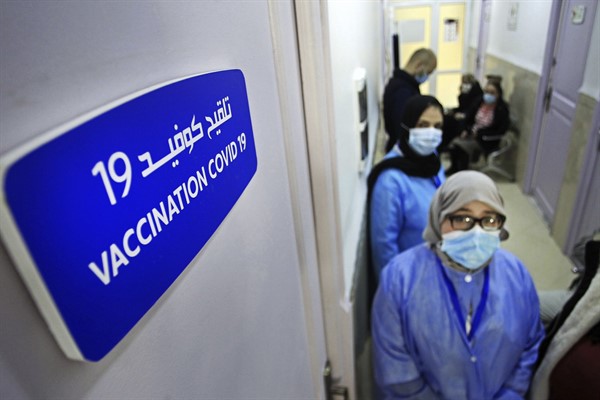Many countries across the Middle East and North Africa, or MENA, region have faced critical challenges in ensuring the effective and equitable vaccination of their citizens against COVID-19. With a few exceptions, like Morocco, Israel and several Gulf states, countries in the region have faced difficulties in securing sufficient doses due to logistical constraints, poor planning and vaccine hesitancy. As of mid-August, only 21 percent of the region’s population had received at least one dose, and less than 13 percent were fully vaccinated. This puts the region far behind the developing country average of 36 percent with at least one dose and 22 percent fully vaccinated. Moreover, while some countries have accelerated their vaccination campaigns under the pressure of recent COVID-19 surges, other campaigns seem to be slowing or stalling. As countries brace for new waves of the pandemic, MENA governments—and their international supporters—must find ways to address the root causes of their halting vaccination campaigns.
Reflecting global trends, wealthier MENA countries have been highly successful in their inoculation campaigns. The United Arab Emirates, in fact, leads the world, with 85 percent of its population having received at least one dose of the vaccine. The UAE’s neighbors in the Gulf have logged similar results, with at least 62 percent of their populations receiving at least one dose of the vaccine; Oman is an exception, at 48 percent. Several middle-income countries in the MENA region are also carrying out successful vaccination campaigns. Particularly noteworthy is Morocco, which has vaccinated 49 percent of its population with at least one dose. Jordan has provided 34 percent of its population with at least one dose, and Tunisia, which had been facing a dangerous health crisis, has done the same for 35 percent.
In contrast, most low- and middle-income countries in the region have made little progress in inoculating their populations. Nearly 20 percent of people in Lebanon have received at least one dose. Similarly, Iran, which has recently accelerated vaccine distribution, has managed to reach only 21 percent. Libya and Algeria are faring poorly, at 14 percent and 7.7 percent, respectively. Egypt, the region’s most populous country, has provided only 5 percent of its population with at least one dose, while Iraq has managed just over 2 percent. In conflict-stricken Syria and Yemen, around 1 percent of the population has received any vaccination for COVID-19.

